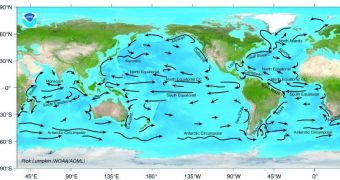Deep-water circulation apparently influenced the surface temperatures of the Atlantic Ocean by a great margin during the late Cretaceous Period, a team of investigators from the University of Missouri found. The discovery could be used to determine the effects of global warming on the planet.
Understanding how elevated greenhouse gas concentrations in Earth's atmosphere will change global climate is a very complex process, and one that requires a wealth of data. By adding a time line component into the mix, researchers could potentially create even more precise models.
The UM group reveals that the changes analyzed in this research occurred about 70 million years ago, which is roughly 4.5 million years before the Cretaceous-Tertiary (K-T) extinction event that wiped out all dinosaurs.
Throughout the late Cretaceous, our planet's atmosphere was characterized by a period of warming, which placed increased pressure on ecosystems and species. A similar thing is happening today as well.
“We are examining ocean conditions from several past greenhouse climate intervals so that we can understand better the interactions among the atmosphere, the oceans, the biosphere, and climate,” UM College of Arts and Sciences geological sciences professor Kenneth MacLeod explains.
“The Late Cretaceous Epoch is a textbook example of a greenhouse climate on earth, and we have evidence that a northern water mass expanded southwards while the climate was cooling,” the team leader goes on to say.
“At the same time, a warm, salty water mass that had been present throughout the greenhouse interval disappeared from the tropical Atlantic,” he adds. One of the main changes to affect late Cretaceous temperatures occurred in water currents around Greenland, Daily Galaxy reports.
Before the warming period began 70 million years ago, most waters around the island were sinking to the ocean floor, before moving towards the South Pacific. However, during the event, this flow was replaced by surface waters coming in from the South Atlantic.
As a direct result, the northern sector of the Atlantic Ocean began to warm up excessively, while the rest of the world's oceans became cooler. These discovery was made possible by analyzing neodymium isotopes found in the teeth and bones of fish.
“Understanding the degree to which climate influences circulation and vice versa is important today because carbon dioxide levels are rapidly approaching levels most recently seen during ancient greenhouse times,” MacLeod believes.
“In just a few decades, humans are causing changes in the composition of the atmosphere that are as large as the changes that took millions of years to occur during geological climate cycles,” he adds.
Details of the work appear in a paper entitled “Changes in North Atlantic circulation at the end of the Cretaceous greenhouse interval,” which was published in the October online issue of the top journal Nature Geoscience.

 14 DAY TRIAL //
14 DAY TRIAL //